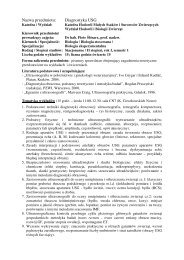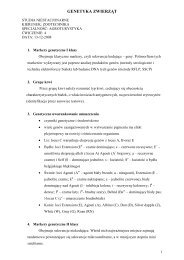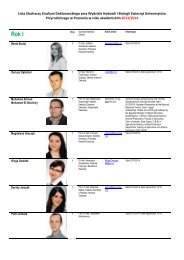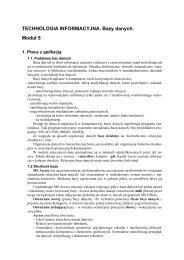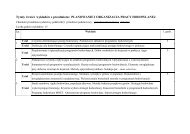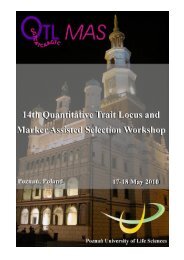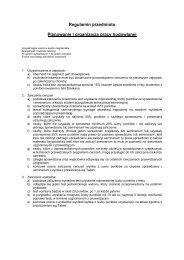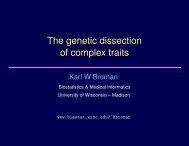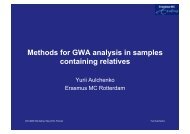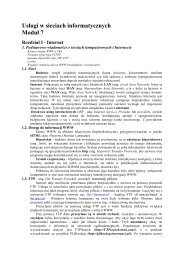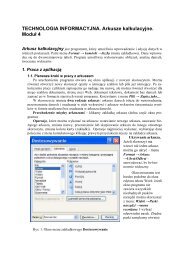Genomic Selection Using Best Linear Unbiased Prediction with a ...
Genomic Selection Using Best Linear Unbiased Prediction with a ...
Genomic Selection Using Best Linear Unbiased Prediction with a ...
Create successful ePaper yourself
Turn your PDF publications into a flip-book with our unique Google optimized e-Paper software.
<strong>Genomic</strong> <strong>Selection</strong> <strong>Using</strong> <strong>Best</strong><br />
<strong>Linear</strong> <strong>Unbiased</strong> <strong>Prediction</strong> <strong>with</strong><br />
a Trait Specific Relationship<br />
Matrix<br />
Zhe Zhang<br />
Supervisor:<br />
Prof. Qin Zhang (CAU)<br />
Dr. DJ de Koning (RI)<br />
China Agricultural University (CAU), Beijing, China<br />
Roslin Institute (RI), University of Edinburgh, Edinburgh, UK
<strong>Genomic</strong> selection (GS)<br />
• Marker assisted selection on whole genome<br />
high density markers.<br />
Require high LD between QTL and markers<br />
• Many advantages over traditional methods<br />
Explain more genetic variance,<br />
Higher accuracy<br />
Shorter generation interval<br />
• Cost effective and widely implemented in dairy<br />
cattle genetic evaluation.<br />
May be not cost effective for other livestock species
<strong>Genomic</strong> selection: models<br />
• Marker (segment) effects model:<br />
y<br />
m<br />
= Xb<br />
+ ∑<br />
i=1<br />
Zi gi<br />
+<br />
•Total genetic effect model:<br />
y = Xb<br />
+ Zu<br />
+<br />
e<br />
e<br />
(2)<br />
(1)<br />
Assumption on the genetic<br />
architecture of trait of interest<br />
Model 1 Model 2<br />
Infinitesimal<br />
Non-infinitesimal<br />
RR-BLUP<br />
BayesA, B,C,…<br />
G-BLUP<br />
TA-BLUP
Relationship matrix in MME<br />
y = Xb<br />
+ Zu<br />
+<br />
e<br />
Vu<br />
=<br />
⎧<br />
⎪<br />
⎨<br />
⎪<br />
⎩<br />
A<br />
G<br />
T<br />
σ<br />
σ<br />
a<br />
σ<br />
2<br />
u<br />
2<br />
u<br />
2<br />
u<br />
traditional BLUP pedigree<br />
G-BLUP markers<br />
TA-BLUP markers & weights<br />
A: numerator relationship matrix<br />
G: realized relationship matrix<br />
TA: trait specific relationship matrix
Trait specific relationship matrix (TA)<br />
S ijk AA Aa aa<br />
∑<br />
2<br />
∑<br />
2<br />
m = 1 n=<br />
1<br />
S = I<br />
ijk<br />
mn<br />
4<br />
AA<br />
1 0.5 0<br />
Aa 0.5 0.5 0.5<br />
S<br />
ij<br />
=<br />
N<br />
N<br />
∑ S w ∑<br />
= 1 ijk k =<br />
k<br />
k<br />
1<br />
w<br />
k<br />
aa<br />
0 0.5 1<br />
G-BLUP:<br />
Wk=1 G<br />
TA-BLUP: Wk=|g k | TA
Aim of this study<br />
• Assess the performance of TA-BLUP using the<br />
common dataset of this workshop.<br />
Trait Q only.<br />
• Implement TA-BLUP in low density marker chips.<br />
Low density marker were selected based on<br />
their size of estimated effects.
Methods<br />
• BayesB<br />
Bayesian variable selection method B<br />
(Meuwissen et al. 2001)<br />
• RRBLUP<br />
Ridge regression BLUP (Meuwissen et al. 2001)<br />
• TABLUP<br />
TAB: TABLUP <strong>with</strong> weights from BayesB<br />
TAP: TABLUP <strong>with</strong> weights from RRBLUP.
Methods<br />
Step 1: marker effect estimation<br />
BayesB, RRBLUP GEBV<br />
Step 2: construct TA matrix<br />
All markers + w TA TABLUP GEBV<br />
Subset markers + w TA TABLUP GEBV
Distribution of estimated marker effects<br />
Estimated marker effects<br />
0 1 2 3<br />
0.00 0.05 0.10 0.15<br />
BayesB<br />
RRBLUP<br />
CHR-1<br />
CHR-2<br />
CHR-3<br />
CHR-4<br />
CHR-5<br />
0 2000 4000 6000 8000 10000<br />
Position
Correlations of GEBVs between methods<br />
RR-BLUP<br />
BayesB<br />
TA-P<br />
TA-BLUP<br />
TA-B<br />
RR-BLUP 0.980 0.977 0.969<br />
BayesB 0.938 0.969 0.981<br />
TA-P 0.985 0.959 0.992<br />
TA-B 0.942 0.999 0.962<br />
Upper triangle: correlation in reference population (F0 - F3)<br />
Lower triangle: correlation in the young individuals (F4)
Correlation of GEBVs between TA-BLUP using low density<br />
markers and RR-BLUP or BayesB using all markers<br />
10031 5000 2000 1000 500 200 100<br />
F0-F3<br />
F4<br />
1<br />
0.96<br />
Correlation<br />
0.92<br />
0.88<br />
0.84<br />
0.8<br />
TAB-BayesB<br />
TAB-RRBLUP<br />
TAP-BayesB<br />
TAP-RRBLUP<br />
10031 5000 2000 1000 500 200 100<br />
No. Markers
Conclusions<br />
• The trait (Q) simulated in the common dataset<br />
obviously departed from the infinitesimal model.<br />
Bayesian method should show advantage over RR-BLUP.<br />
• TA-BLUP performed as well as BayesB <strong>with</strong> all<br />
markers. (BayesB, TA-BLUP)<br />
• With only a proportion of all markers, TA-BLUP can<br />
perform nearly equivalent to HD-BayesB.<br />
GS <strong>with</strong> low density markers might be cost-effective by<br />
using TA-BLUP. (TA-BLUP 500)
Acknowledgements



